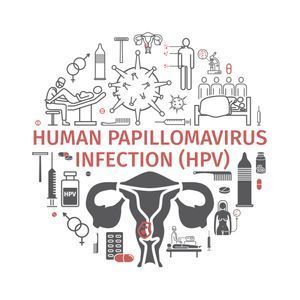HPV Screening
The only method for diagnosing HPV is to perform PCR assay, where DNA fragments of the virus are isolated and amplified. The HPV 16/18 test has extremely high specificity and sensitivity. It is the earliest prognostic marker for cervical cancer (the second most common cancer after breast cancer among women).
The test detects all 14 oncogenic types of HPV associated with a high risk of developing cervical cancer. The test does NOT detect a specific virus type and the result represents a total value - positive or negative.
Diagnostic Range: HPV 16, 18, 31, 33, 35, 39, 45, 52, 56, 58, 59, 66, 53, 70
Diagnostic Method: PCR Assay
Research Material: Cervical specimen / Biopsy tissue
Results within: 1-5 business days
Fee: BGN 66
Diseases associated with the range of HPV screening:
Cervical dysplasia, cervical cancer; Oral cavity cancer; Cancer of the vulva and vagina; Penile cancer; Anal cancer;
Download Our Brochure
Cobas® HPV Test
The only method for diagnosing HPV is to perform PCR assay, where DNA fragments of the virus are isolated and amplified. The Cobas® HPV test is the earliest prognostic marker for cervical cancer (the second most common cancer after breast cancer among women). Cobas® HPV is the only HPV test certified by the FDA and has extremely high specificity and sensitivity. The test detected 14 high-risk types of HPV associated with a high risk of developing cervical cancer, differentiating types of HPV 16 HPV 18, that cause 70% of cervical cancers.
Diagnostic Range: HPV 16 and HPV 18 + screening for 12 high-risk HPV types (31,33,35,39,45,51,52,56,58,59,66,68)
Diagnostic Method: Cobas 4800 PCR Assay
Research Material: Cervical specimen
Results within: 1-5 business days
Fee: BGN 90
Clinical application
Cervical dysplasia; Cervical cancer; Oral cancer; Cancer of the vulva and vagina; Penile cancer; Anal cancer; Genital warts; Respiratory papillomatosis
Download Our Brochure
HPV Genotyping of 12 Types
The only method for diagnosing HPV is to perform PCR assay, where DNA fragments of the virus are isolated and amplified. The HPV genotyping test has extremely high specificity and sensitivity. It is the earliest prognostic marker for cervical cancer (the second most common cancer after breast cancer among women). The test detects 12 oncogenic types associated with a high risk of developing cervical cancer. It distinguishes different virus types, and the result is a specific conclusion (positive / negative) for each HPV type.
Diagnostic Range: HPV 16, 18, 31, 33, 35, 39, 45, 52, 56, 58, 59, 66
Diagnostic Method: PCR Assay
Research Material: Cervical specimen / Biopsy tissue
Results within: 1-5 business days
Fee: BGN 110
Diseases associated with the range of the HPV genotyping of 12 types test
Cervical dysplasia; Cervical cancer; Oral cancer; Cancer of the vulva and vagina; Penile cancer; Anal cancer.
Download Our Brochure
HPV Genotyping of 33 Types
The only method for diagnosing HPV is to perform PCR assay, where DNA fragments of the virus are isolated and amplified. The HPV high / medium / low risk types genotyping test has extremely high specificity and sensitivity. It is the earliest prognostic marker for cervical cancer (the second most common cancer after breast cancer among women). The test detects 33 types associated with high / medium / low risk of developing cervical cancer. It distinguishes different virus types, and the result is a specific conclusion (positive / negative) for each HPV type.
Diagnostic Range: HPV 6, 11, 16, 18, 26, 31, 35, 39, 40, 42, 43, 44, 45, 51, 52, 53, 54, 55, 56, 57, 58, 59, 61, 66, 68, 70, 71, 72, 73, 81, 82, 84
Diagnostic Method: PCR Assay
Research Material: Cervical specimen / Biopsy tissue
Results within: 1-5 business days
Fee: BGN 187
Diseases associated with the range of HPV genotyping of 33 types test
Cervical dysplasia; Cervical cancer; Oral cancer; Cancer of the vulva and vagina; Penile cancer; Anus cancer; Genital warts; Respiratory papillomatosis
Download Our Brochure
ThinPrep® PAP Test
The smear test (PAP test) is a medical test used in prevention of cervical cancer. There are 2 options for cytological screening for cervical cancer: conventional cytology, known as cytosmear and liquid-based cytology - a new generation cytosmear. The latter stands out for its ability for earlier, accurate and definitive diagnosing and is used as a major diagnostic platform in all developed countries.
Diagnostic Range: Gynecological cytology
Diagnostic Method: Liquid-based cytology
Research Material: Cervical specimen in a ThinPrep® container
Results within: 10-14 business days
Fee: BGN 42
Diseases in the range of ThinPrep® PAP test
Cervical dysplasia; Cervical cancer
Download Our Brochure
Download Our Brochure
OncoHPV® Test
The OncoHPV® test is the only laboratory diagnostic approach to detect HPV oncogenic activity. Unlike other HPV tests, which show normal viral load, the OncoHPV® test detects advanced forms of infection that already have viral oncogenicity. The test is useful for determining the HPV infection stage and is the earliest cancer prognostic marker for cervical cancer.
Diagnostic Range: HPV E6 / E7 mRNA of 14 high-risk types
Diagnostic Method: TMA & HPA
Research Material: Cervical specimen in a ThinPrep® container
Results within: 30 business fays
Fee: BGN 120
Diseases associated with the range of the OncoHPV test®
Cervical dysplasia; Cervical cancer; Oral cancer; Cancer of the vulva and vagina; Penile cancer; Anal cancer.
Download Our Brochure
CINtec® PLUS Cytology
CINtec® PLUS Cytology is a triage test for cervical cancer screening and the only one using dual biomarker technology to detect p16 and Ki-67 simultaneously. Thus, it provides a powerful cytological indicator of the presence of oncotransforming HPV infections. Coexpression of p16 and Ki-67 in the same cell is strongly associated with established high-grade cervical lesions and cervical cancer. CINtec® PLUS Cytology objectively identifies transforming HPV infections in women with abnormal PAP cytology screening results and / or HPV positive results. This is a certain indication for doctors about oncotransformation.
Diagnostic Range: p16 and Ki-67 biomarkers
Diagnostic Method: CINtec® PLUS Cytology
Research Material: Cervical specimen in a ThinPrep® container
Results within: 10 -14 business days
Fee: BGN 150
CINtec® Histology
CINtec® Histology provides objectivity to diagnostic interpretation that helps all pathologists identify more cervical disease. The CINtec® Histology test is the only p16 biomarker test CE marked, and U.S. 510(k) cleared for clinical use in the evaluation of cervical biopsy specimens. Pathologists who use CINtec® Histology demonstrate improved diagnostic consistency.
CINtec® Histology enhances identification of occult lesions that may be missed by H&E or morphologic interpretation alone, adding objectivity to cervical biopsy interpretation to help pathologists make informed diagnoses. The adjunctive use of CINtec® Histology helps pathologists ensure the right patient is treated adequately.
Diagnostic Range: Hystology + p16 biomarker test
Diagnostic Method: CINtec® Histology
Research Material: Cervical biopsy specimens
Results within: 10-14 business days
Fee: BGN 150
Clinical application
Cervical dysplasia, Cervical cancer





